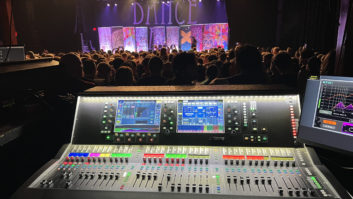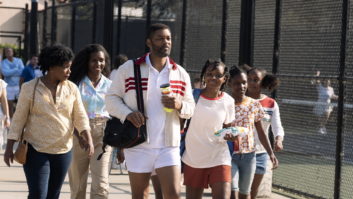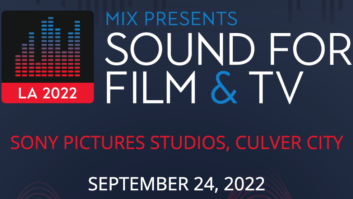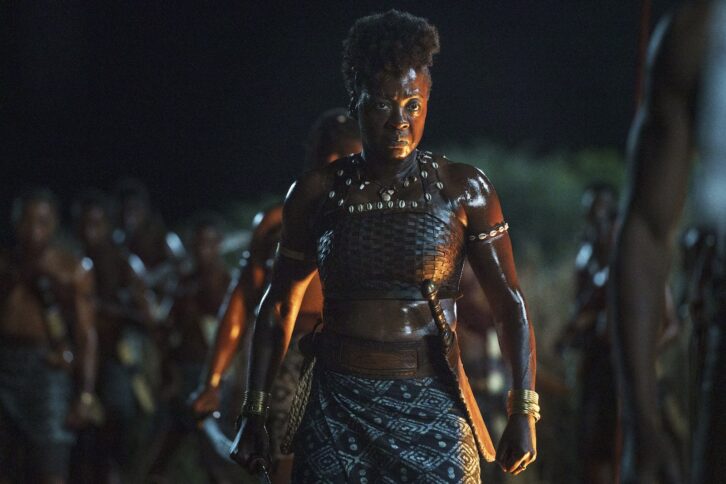
Before the first audience preview of director Gina Prince-Bythewood’s The Woman King, BAFTA and MPSE Award-winning supervising sound editor/sound designer Becky Sullivan had just five weeks of editorial to get the tracks ready for re-recording mixers Tony Lamberti and Kevin O’Connell. Even though there were only 15 weeks total for post sound, the richly layered and vibrant soundtrack doesn’t suggest a compressed schedule at all.
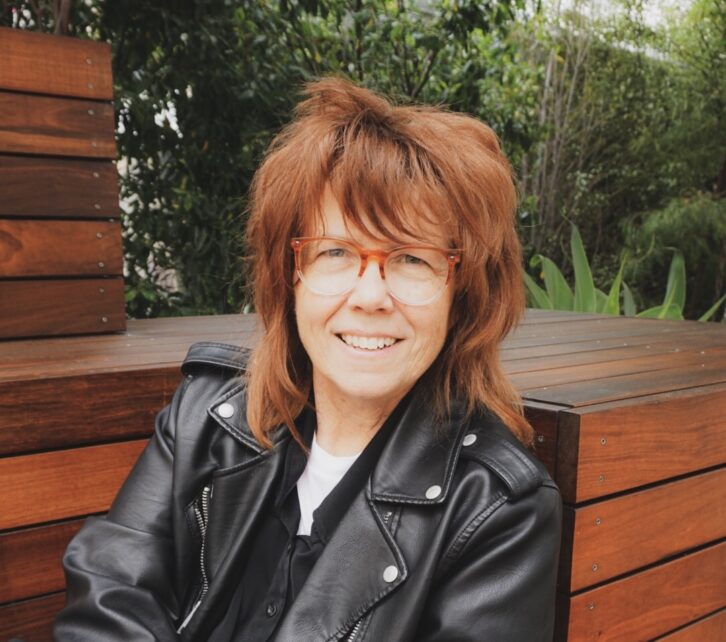
“It was a very short amount of time for something so epic in scale,” says Sullivan, who also had a compact crew on the film. “I like to keep a small crew that I work with all the time. I had four editors with me in the first five weeks, and that went down to three for the remainder of the schedule. On the mixing side, we had Tony [Lamberti], Kevin [O’Connell], and our mix tech Kyle Arzt.”
The Woman King—a historical drama set in western Africa in the 1820s—follows a group of women warriors known as Agojie, who fight to protect the Dahomey kingdom. Sullivan wasn’t able to capture custom recordings of African ambiances and wildlife, nor record extensive loop group sessions to help build out backgrounds. Instead, she dug deep into her sound library, pulling choice bits from tracks and individual sound effects to craft layers of realistic details that define the environment and also the vibe.
For instance, the women-only Agojie warrior section of the Dahomey royal palace sounds distinctly feminine yet tough, in comparison to the ambiance she built for the rooms occupied by the king’s wives and children, which sounds feminine and soft, more high-pitched, with children’s voices mixed in.
“I went through the production takes and our vast effects library listening for the right tone for how these places, like the marketplace, were supposed to feel,” Sullivan says. “I’m really big on BGs [backgrounds], as is Tony [Lamberti]. I like to think about an emotional landscape of sound. For me, it was about supporting different emotional aspects for the women—the strength of the women, the vulnerability, the bravery, the loneliness.”
DIALOG AND LOCATION
Being a period piece, loop group proved an important element for the sound of the port city. Sullivan recorded Portuguese, German and French group ADR for the ambiance of traders buying slaves. She explains, “I didn’t use any English in the backgrounds there because I didn’t want to pull the audience’s ear and break the spell. In using language more as a sound effect than dialog, I’m able to create an atmosphere of people negotiating or calling out prices; we understand what’s happening without calling attention to what’s being said, so we can focus on what the actors are saying in English.”
Director Prince-Bythewood was keen on only using the production dialog for The Woman King, and the crew benefited from excellent recordings by production sound mixer Derek Mansvelt. Even so, locations can be tough, and Sullivan’s first challenge on the film was to clean up a waterfall scene in which Agojie trainee Nawi meets Malik (a visitor from Portugal whose mother was Dahomey). “You could barely understand them it was so thick with waterfall, but we cleaned it up using iZotope RX and our other tools and tricks,” Sullivan explains. “We sent Gina and picture editor Teri [Terilyn A. Shropshire] that scene, and they were pleasantly surprised at how good it sounded.”

Another challenging location with water was in the bathing cavern where Agojie General Nanisca converses with Nawi. Ventilation fans on the set marred the production tracks, but Sullivan was able to salvage them and avoid ADR. On the dub stage, Emmy and MPSE Award-winning re-recording mixer Lamberti (who handled the effects/BGs/Foley) mixed ambiance from production with Sullivan’s crafted room tone, effects and Foley (from Post Creations).
Lamberti says: “I used Cinematic Rooms from LiquidSonics to put a little bit of reverb on it so it felt like being in a cave. I spread that into the Dolby Atmos surround field to create an overall tonal feel, which wraps around and over the audience. That gives the scenes a false sense of a ceiling up there. Enclosed spaces like that are amazing for Atmos.”
Sullivan recorded very little ADR, using it sparingly for very specific lines, such as for the chanting and singing performed by the Agojie during ceremonies and rituals. According to Lamberti, some chants were developed while the actors were filming on location, so there were numerous production takes of the Agojie actors practicing the songs, and that is what’s in the final movie. Sullivan supported that with ADR by recording solos for the actors shown on screen so that as the camera pans by an actor, their voice could be featured in the soundtrack.
During the ceremonies—such as the battle dance that precedes the big battle between the Dahomey and Oyo kingdoms—the Agojie warriors dance and sing, stomping their bare feet on the ground while beating machetes against their chests to add to the rhythm. But the machetes on set were made of plastic so those sounds needed to be removed from the production tracks and replaced with more appropriate heavy metallic impacts.
“The actors spent hours and hours every day doing weapons training, martial arts training, and other training to pull off the stunts themselves. They worked hard, and we really worked hard on the sound to support all that they did,” says Lamberti.
THE SOUND OF BATTLE
Prince-Bythewood had a definite idea for how the machetes should sound in The Woman King. They needed to have a deep, thick, metal sound that wasn’t clangy like a sword. When the Agojie fought against opponents that used swords, the machete and sword sounds had to be markedly different. Working with an abundance of metallic impacts, as in the battle sequences, can be challenging in the mix. Lamberti notes that “it can be very sharp and grating to one’s ear. You can’t just roll off all the top end; you need to have some high-frequency information or it sounds dull. Using the channel-strip plug-in EVO Channel from Flux/IRCAM, I could super fine-tune very specific frequencies, targeting just the ones that hurt people’s ears. So you hear the hits and it still sounds like metal, but it doesn’t feel like sticking an ice pick in your ear.”
Each machete is meant to be unique to the warrior, so Sullivan created a distinct palette of sounds for each machete. For instance, Nanisca’s machete is quite weighty. There’s a scene in which she offers up her machete to trainee Nawi and asks her to strike the head off of a wicker dummy. When Nawi takes the machete from Nanisca, the tip plunges to the ground with a chunky thud. The blade of Nawi’s machete—which she earns later in the film—is perforated by several holes. During a battle with the Oyo, she ties it to a rope and swings it around. The air singing through the holes and the rope’s whooshes create a signature “zuzzing” sound that features prominently in the mix at that moment, while the music takes a back seat.
The rhythm of the battle scenes plays both in the sound effects and the drum tracks of composer Terence Blanchard’s score. Those elements together could easily become overwhelming, but Lamberti and O’Connell (who handled dialog/music) have them hand-off in the mix letting the visuals guide their decisions on which elements to pull back or feature.
“Those battles are very much a dance of music and sound effects working together so that the hits in the music aren’t getting killed by the sound effects hits, and vice versa,” Lamberti says. “It’s very subtle; we’re not doing huge moves. Sometimes we’ll suck the music out completely, like in the battle with the Oyo, but we typically find places where we can subtly bob and weave the two instead, so music will be hotter for a moment, and then the effects. We try to really be cognizant of that when we’re mixing big, busy action sequences.”
The Woman King was mixed in Dolby Atmos in the Cary Grant Theater at Sony Pictures Post-Production Studios, using an Avid Dual 48-fader S6 Console System running Avid Pro Tools HDX, with monitoring via a custom JBL/Sony theatrical 48-speaker system featuring three TS24 Turbosound subwoofers.
The battle reactions from production (e.g., grunts, screams and other vocalizations) were also rendered unusable due to plastic impacts in the tracks. Sullivan notes that “each time somebody was knifed or had their throat cut, 99.9 percent of it was sound effects and not production. Each little sound I hand-cut because a person’s reaction is going to make or break a moment. We also added the sounds of slicing, gore and blood to suggest intense violence without actually showing it, because the film was going for a PG-13 rating. So there’s not a lot of bloodshed, but we needed to feel/hear like there was.”
DANCING WITH EFFECTS
The battle dance sequence in The Woman King was the most challenging section of the film for sound editorial and mix. The sequence cuts between the battle dance with chanting and singing, the construction of exploding termite mounds, Nanisca’s speech, and shots of the warriors preparing their bodies for battle.
“Teri [Shropshire] did a fabulous job on the cut, but we had to make these different aspects of the sequence work together sonically,” says Sullivan. “We were dealing with plastic machete impacts on their skin and on the mics under their costumes, so we had ADR and sound effects challenges, and music was challenging, too. It took a lot of time to work through to make it truly cohesive.”
Lamberti adds, “We had to investigate every single thing in there to figure out how the pieces all fit together in order to make that become as one. It was a section that everybody was concerned about throughout the entire dub. But I can’t think of another stretch in any other movie I’ve worked on—and I’m coming up on 200 films now—that is this amazing. Everything about it—the music, the way the sound is working, the emotion, the action—is perfect. It’s as perfect as we could have made it.”
Another challenging scene was the Agojie trainee test, where the warriors-in-training must get through a series of obstacles to prove their mettle, the first one being a mass of vines barbed with three-inch thorns. The thorns, like the machetes, weren’t real. They were made of rubber, so Sullivan and her sound team needed to design wicked thorn snaps and the resultant skin abrasions and punctures.
LISTEN: Mix Sound For Film & TV’s Sound Mixing, Editing and Tech Panels
Lamberti says, “Teri was detail-oriented and very specific about where and when we needed to hear a snap. We went through it frame by frame, placing a snap here and a break there, and a snap when we see a thorn enter Nawi’s foot.”
Crowds were also a vital part of this sequence. The Agojie warriors, the Dahomey soldiers, the King and his wives, and the Portuguese traders were present for the trainees’ test. “Gina wanted to keep the crowd right in the action, reacting to the race, but there were times when the extras on set were not doing exactly that,” Sullivan recalls. “The loop group didn’t work so well, so I found different bits of crowd to weave into the backgrounds. It took a while to build the right emotion into that race.”
In terms of mixing this sequence, Lamberti points out that “we needed to hear all the details of what the trainees experienced, like Ode hitting the wooden wall. Teri remembered the great sound of that from the production track, and we blended it with Foley. There were these crowd reactions, and the score was going a hundred miles an hour.”
Sullivan concludes by praising O’Connell’s handling of the dialog and score in the mix, saying, “Kevin did a phenomenal job. The dialog was extremely challenging. It was all recorded outside on location in South Africa, and his work on the score was something that nobody else in town could have done. I was in awe of his mastery of hundreds of music tracks. I don’t know that he’s worked harder on any other music than he has on the music for The Woman King. It was amazing.”

